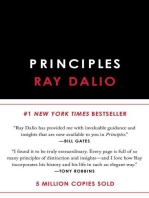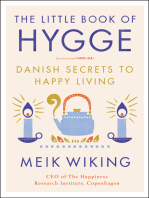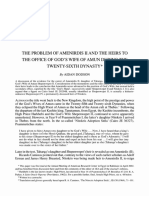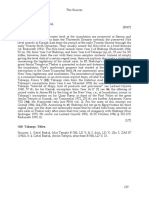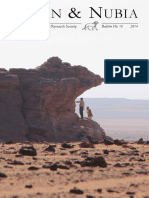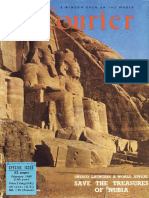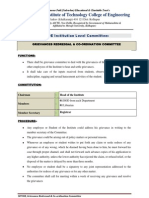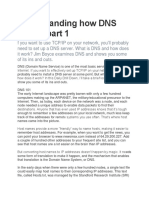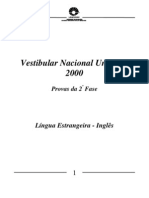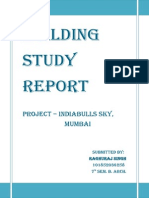Sudan: Can Treasure of Nubian Queen Amanishaketo Be Retrieved?
Sudan: Can Treasure of Nubian Queen Amanishaketo Be Retrieved?
Uploaded by
Jac StrijbosCopyright:
Available Formats
Sudan: Can Treasure of Nubian Queen Amanishaketo Be Retrieved?
Sudan: Can Treasure of Nubian Queen Amanishaketo Be Retrieved?
Uploaded by
Jac StrijbosOriginal Title
Copyright
Available Formats
Share this document
Did you find this document useful?
Is this content inappropriate?
Copyright:
Available Formats
Sudan: Can Treasure of Nubian Queen Amanishaketo Be Retrieved?
Sudan: Can Treasure of Nubian Queen Amanishaketo Be Retrieved?
Uploaded by
Jac StrijbosCopyright:
Available Formats
Sudan: Can Treasure of Nubian Queen Amanishaketo Be Retrieved? - ... file:///C:/Users/Gebruiker/Downloads/Sudan Can Treasure of Nubian...
SudaNow (Khartoum) 7 AUGUST 2017
Sudan: Can Treasure of Nubian Queen Amanishaketo Be Retrieved?
ANALYSIS
By Ishraga Abbas
Khartoum Priceless 57 Pieces of pure gold, studded with jewels, were stolen in open daylight from her pyramid in Meroe in the early
19th Century and nobody can tell how this historically and artistically invaluable wealth can be returned to the country.
The treasure is now on display in Munich, Germany.
The treasure of the Kandake (queen) Amanishakheto was discovered in her pyramid at Meroe, however probably not in a funerary
chamber inside the core of the pyramid as claimed by the Italian explorer, treasure-hunter, Giuseppe Ferlini, but more likely in the burial
chamber below the pyramid.
General Manager of Sudan's Public Antiquities and Museums Corporation Abdelrahman Ali describes the theft "as the first documented
robbery in the history of mankind" and "one of the biggest antiquities' thefts Sudan had seen."
Amanishakheto was a Nubian Queen, a valiant fighter and one of the most outstanding monarchs of the Sudanese Meroitic Kushite
civilization of ancient Sudan. She is believed to have reigned from 10 BC to 1 AD. Her name was found in a manuscript in Meroe in
which she was named "The Queen and The Ruler". Queen Amanishakheto is known to have repelled the invading Roman forces sent to
conquer Nubia by Emperor Augustus. Consequently, Queen Amanishakheto obliged the invading Roman army to sign a fair peace deal.
Amanishakheto is known from several monuments. She is mentioned in the Amun-temple of Kawa, on a stela from Meroe, in inscriptions
of a palace building found at Wad Bannaqa, from a stela found at Qasr Ibrim, another stela from Naqa and in her pyramid at Meroe.
Dr. Ali explains that Giuseppe Ferlini (a medical doctor in some reports) was in the company of the expedition sent by Egypt's ruler
Mohammad Ali Pasha to conquer Sudan in 1821 AD that was also accompanied by several treasure and antiquities hunters. Giuseppe
Ferlini's passion for treasures and antiquities led him to the Northern cemetery, east of the Royal City of Meroe (210 KM North of
Khartoum) and to Pyramid No 6 in the Royal City, where the Queen was buried. Giuseppe Ferlini and his men in 1834 destroyed the
pyramid to find what it was hiding.
Unlike Egyptian ones, the structure of Kushite pyramids does not make access to the inner chambers possible. Considering that, Ferlini
and his men completely dismantled the pyramid from the top down. It is possible that he thought the chamber was inside it when in fact
he was already beneath it. The poor pyramid was destroyed to its foundations!
In the process, Giuseppe Ferlini and his men removed granite blocks inside the pyramid to discover a rectangular room. The room walls
were made of granite blocks parallel to the exterior staircase of the pyramid's facet. The room was 5 feet high. Inside the pyramid was
found a big bowel covered with a cotton sheet. Below was a four-leg bed that looked like a platform or a coffin and then the Queen's
treasure.
Dr. Ali said the treasure was made of a big collection of the Queen's jewels and ornaments and other royal belongings all of which were
looted by Ferlini who later on sold them to a Prussian king in Germany. The collection then changed hands among European kings and
princes until it finally settled down in the Staaliche Museum Agyptischer Kunst in Munich, under the name 'Jewels of Queen
Amanishakheto.'
Dr. Ali said the collection "was carved in a superb artistic order". The treasure's collection is made up of 6 golden bracelets beautified
with crystal and gems. It also includes a golden and crystal armlet and a necklace made of gems, ceramics and glass. Another necklace
among the collection is made of 12 golden and crystal beads.
The treasure also contains 7 golden beads carefully beautified with crystal, a vase with two bronze supports, a perfume container with a
wooden cover, a tiny statue for the god Amun made of gold and red agate, two golden statues of lions, a statue of a fox and another
statue of the lotus flower.
It also contains a chain made of seven pieces of gold containing carvings of a goddess, a golden chain containing a carving of a beetle,
a six-piece golden chain containing the key-like emblem of the god Amun.
Another characteristic of the treasure is the presence of a big collection of royal stamps in twelve groups, each group containing four
pieces, then three pieces and then two pieces. All these stamps are made of pure gold and carry carvings of the god Amun and other
gods all in different positions, either presenting a crown, sitting on the throne, or defeating the enemy etc... Pictures of lions, sheep,
beetles and birds can also be seen. Finally, three small golden bells used for calling attendants are also found in the collection. The
presence of this varied number of the stamps may signify the progress of old Nubian kingdoms and how progressive was Queen
Amanishaketo in running the affairs of her kingdom, as every stamp may refer to a certain administration or royal order.
German Historian Karl Heinz Priese, who explored historical monuments in northern Sudan has revealed some resourceful information
about this treasure, how it was stolen, how it was sold and how it was dispersed among European museums that competed to obtain
valuable treasures and artefacts.
In his book "The Gold of Meroe",Priese gives a precise description of every piece of this collection and after every description he gives
an explanation of the meanings of all the drawings and inscriptions each piece had contained.
He also accounts for a lot of information about the civilization of Meroe at that time.
The book is worth reading for the valuable information it contains about this treasure. The reader would, in addition, entertain himself
viewing the photos of the treasure that clearly show the marvellous drawings and inscriptions on every piece of the collection.
Dr. Ali believes that the treasure can be retrieved in the future if and when Sudan fulfils the UNESCO's related conditions and
agreements in this respect.
In the meantime, he hoped, the museum authorities may allow the people of Sudan to see the treasure on display at the National
Museum here in Khartoum.
END
1 van 2 11-08-17 10:19
Sudan: Can Treasure of Nubian Queen Amanishaketo Be Retrieved? - ... file:///C:/Users/Gebruiker/Downloads/Sudan Can Treasure of Nubian...
YH/AS
Post your comments
http://
Your email address will not be published. Required fields are marked *
Name *
Email *
Your comment *
Copyright 2017 SudaNow. All rights reserved. Distributed by AllAfrica Global Media (allAfrica.com). To contact the copyright holder directly for corrections or for permission to
republish or make other authorized use of this material, click here.
AllAfrica publishes around 900 reports a day from more than 150 news organizations and over 500 other institutions and individuals, representing a diversity of positions on every
topic. We publish news and views ranging from vigorous opponents of governments to government publications and spokespersons. Publishers named above each report are
responsible for their own content, which AllAfrica does not have the legal right to edit or correct.
Articles and commentaries that identify allAfrica.com as the publisher are produced or commissioned by AllAfrica. To address comments or complaints, please Contact us.
AllAfrica is a voice of, by and about Africa - aggregating, producing and distributing 900 news and information items daily from over 150 African news
organizations and our own reporters to an African and global public. We operate from Cape Town, Dakar, Lagos, Monrovia, Nairobi and Washington DC.
2017 AllAfrica
AllAfrica - All the Time
2 van 2 11-08-17 10:19
You might also like
- The Subtle Art of Not Giving a F*ck: A Counterintuitive Approach to Living a Good LifeFrom EverandThe Subtle Art of Not Giving a F*ck: A Counterintuitive Approach to Living a Good LifeRating: 4 out of 5 stars4/5 (5936)
- The Gifts of Imperfection: Let Go of Who You Think You're Supposed to Be and Embrace Who You AreFrom EverandThe Gifts of Imperfection: Let Go of Who You Think You're Supposed to Be and Embrace Who You AreRating: 4 out of 5 stars4/5 (1107)
- Never Split the Difference: Negotiating As If Your Life Depended On ItFrom EverandNever Split the Difference: Negotiating As If Your Life Depended On ItRating: 4.5 out of 5 stars4.5/5 (882)
- Grit: The Power of Passion and PerseveranceFrom EverandGrit: The Power of Passion and PerseveranceRating: 4 out of 5 stars4/5 (598)
- Hidden Figures: The American Dream and the Untold Story of the Black Women Mathematicians Who Helped Win the Space RaceFrom EverandHidden Figures: The American Dream and the Untold Story of the Black Women Mathematicians Who Helped Win the Space RaceRating: 4 out of 5 stars4/5 (925)
- Shoe Dog: A Memoir by the Creator of NikeFrom EverandShoe Dog: A Memoir by the Creator of NikeRating: 4.5 out of 5 stars4.5/5 (545)
- The Hard Thing About Hard Things: Building a Business When There Are No Easy AnswersFrom EverandThe Hard Thing About Hard Things: Building a Business When There Are No Easy AnswersRating: 4.5 out of 5 stars4.5/5 (353)
- Elon Musk: Tesla, SpaceX, and the Quest for a Fantastic FutureFrom EverandElon Musk: Tesla, SpaceX, and the Quest for a Fantastic FutureRating: 4.5 out of 5 stars4.5/5 (476)
- Her Body and Other Parties: StoriesFrom EverandHer Body and Other Parties: StoriesRating: 4 out of 5 stars4/5 (831)
- The Emperor of All Maladies: A Biography of CancerFrom EverandThe Emperor of All Maladies: A Biography of CancerRating: 4.5 out of 5 stars4.5/5 (274)
- The World Is Flat 3.0: A Brief History of the Twenty-first CenturyFrom EverandThe World Is Flat 3.0: A Brief History of the Twenty-first CenturyRating: 3.5 out of 5 stars3.5/5 (2271)
- The Little Book of Hygge: Danish Secrets to Happy LivingFrom EverandThe Little Book of Hygge: Danish Secrets to Happy LivingRating: 3.5 out of 5 stars3.5/5 (419)
- The Yellow House: A Memoir (2019 National Book Award Winner)From EverandThe Yellow House: A Memoir (2019 National Book Award Winner)Rating: 4 out of 5 stars4/5 (99)
- Devil in the Grove: Thurgood Marshall, the Groveland Boys, and the Dawn of a New AmericaFrom EverandDevil in the Grove: Thurgood Marshall, the Groveland Boys, and the Dawn of a New AmericaRating: 4.5 out of 5 stars4.5/5 (270)
- The Sympathizer: A Novel (Pulitzer Prize for Fiction)From EverandThe Sympathizer: A Novel (Pulitzer Prize for Fiction)Rating: 4.5 out of 5 stars4.5/5 (122)
- Team of Rivals: The Political Genius of Abraham LincolnFrom EverandTeam of Rivals: The Political Genius of Abraham LincolnRating: 4.5 out of 5 stars4.5/5 (235)
- A Heartbreaking Work Of Staggering Genius: A Memoir Based on a True StoryFrom EverandA Heartbreaking Work Of Staggering Genius: A Memoir Based on a True StoryRating: 3.5 out of 5 stars3.5/5 (232)
- Tamang-Asynchronous-Class-Accomplishment-Report Day 4Document3 pagesTamang-Asynchronous-Class-Accomplishment-Report Day 4Cher An Jie100% (5)
- On Fire: The (Burning) Case for a Green New DealFrom EverandOn Fire: The (Burning) Case for a Green New DealRating: 4 out of 5 stars4/5 (75)
- 49 French Desserts - Saveur PDFDocument112 pages49 French Desserts - Saveur PDFBrandon Cortez100% (9)
- Hot Air Balloon - Baby Mobile Crochet PatternDocument14 pagesHot Air Balloon - Baby Mobile Crochet PatternElena Nitulescu100% (7)
- 223 2-1 Reports Felipe, BDocument44 pages223 2-1 Reports Felipe, BBernard Agcanas FelipeNo ratings yet
- 2016 Tracy Davenport Thesis PDFDocument228 pages2016 Tracy Davenport Thesis PDFJac StrijbosNo ratings yet
- The Unwinding: An Inner History of the New AmericaFrom EverandThe Unwinding: An Inner History of the New AmericaRating: 4 out of 5 stars4/5 (45)
- Fly Cycle 2 Booklet The Lifes of A FlyDocument25 pagesFly Cycle 2 Booklet The Lifes of A FlySjoerd193No ratings yet
- Siat Sw2 Pallet WrapperDocument2 pagesSiat Sw2 Pallet WrapperjoquispeNo ratings yet
- C1 Week 4 Quiz PDFDocument13 pagesC1 Week 4 Quiz PDFshawon hoque100% (1)
- Arnold1Document7 pagesArnold1Jac StrijbosNo ratings yet
- Bonnet5Document17 pagesBonnet5Jac StrijbosNo ratings yet
- The Problem of Amenirdis Ii and The Heirs To The Office of God'S Wife of Amun During The Twenty-Sixth DynastyDocument9 pagesThe Problem of Amenirdis Ii and The Heirs To The Office of God'S Wife of Amun During The Twenty-Sixth DynastyJac StrijbosNo ratings yet
- Abbas2 PDFDocument17 pagesAbbas2 PDFJac StrijbosNo ratings yet
- FHN TaharqoDocument62 pagesFHN TaharqoJac StrijbosNo ratings yet
- Historical Observations On The Military Role of Three Ramesside Viceroys of Kush Mohamed Raafat AbbasDocument11 pagesHistorical Observations On The Military Role of Three Ramesside Viceroys of Kush Mohamed Raafat AbbasJac StrijbosNo ratings yet
- WWW - Pcma.uw - Edu.pl WWW - Wuw.pl: DONGOLA 2009: Pottery From Building I (Kom A) Katarzyna Danys-LasekDocument22 pagesWWW - Pcma.uw - Edu.pl WWW - Wuw.pl: DONGOLA 2009: Pottery From Building I (Kom A) Katarzyna Danys-LasekJac StrijbosNo ratings yet
- The Inscriptions of Tiglath-Pileser III, King of Assyria: Critical Edition, With Introductions, Translations and CommentaryDocument4 pagesThe Inscriptions of Tiglath-Pileser III, King of Assyria: Critical Edition, With Introductions, Translations and CommentaryJac StrijbosNo ratings yet
- Chit TickDocument5 pagesChit TickJac StrijbosNo ratings yet
- Udan Ubia: The Sudan Archaeological Research SocietyDocument12 pagesUdan Ubia: The Sudan Archaeological Research SocietyJac StrijbosNo ratings yet
- Sudan: Can Treasure of Nubian Queen Amanishaketo Be Retrieved?Document2 pagesSudan: Can Treasure of Nubian Queen Amanishaketo Be Retrieved?Jac StrijbosNo ratings yet
- BangkokDocument220 pagesBangkokJac Strijbos100% (3)
- The Royal X-Group TombsDocument13 pagesThe Royal X-Group TombsJac StrijbosNo ratings yet
- Ancient Water Harvesting Methods in The Drylands of The Mediterranean and Western AsiaDocument22 pagesAncient Water Harvesting Methods in The Drylands of The Mediterranean and Western AsiaJac StrijbosNo ratings yet
- Christophe 3Document52 pagesChristophe 3Jac StrijbosNo ratings yet
- A Philanthropist and A Pioneer Sponsor of Medical Research in The SudanDocument19 pagesA Philanthropist and A Pioneer Sponsor of Medical Research in The SudanJac StrijbosNo ratings yet
- American Academy of Religion: Oxford University PressDocument40 pagesAmerican Academy of Religion: Oxford University PressJac StrijbosNo ratings yet
- Palaeogeography, Palaeoclimatology, Palaeoecology: Contents Lists Available atDocument23 pagesPalaeogeography, Palaeoclimatology, Palaeoecology: Contents Lists Available atJac StrijbosNo ratings yet
- Anoniem 125Document2 pagesAnoniem 125Jac StrijbosNo ratings yet
- IRHMI BC StudentManualDocument472 pagesIRHMI BC StudentManualAlvaro Rojas AnzolaNo ratings yet
- Public Interest Litigation - A Boon or A Bane by Abhipasha MohantyDocument15 pagesPublic Interest Litigation - A Boon or A Bane by Abhipasha MohantyLatest Laws Team100% (1)
- Ged 104 - The Contemporary WorldDocument7 pagesGed 104 - The Contemporary World20-53388No ratings yet
- Grievances Redressal CommitteeDocument2 pagesGrievances Redressal Committeesai leenaNo ratings yet
- Democracy, Elections and Governance - ENGLISH BOOKDocument70 pagesDemocracy, Elections and Governance - ENGLISH BOOKNothingNo ratings yet
- LP 5Document5 pagesLP 5Ayessa BantaoNo ratings yet
- English Year 6 Ar2 Paper 2Document8 pagesEnglish Year 6 Ar2 Paper 2KellyLeeNo ratings yet
- Building Upon The Rock: Jay E. JensenDocument6 pagesBuilding Upon The Rock: Jay E. Jensenhenle1No ratings yet
- Understanding How DNS WorksDocument8 pagesUnderstanding How DNS WorksEduardo Andrés Loaiza MataNo ratings yet
- Arl GatewayDocument2 pagesArl Gatewaymasykur_aceh126No ratings yet
- EnglishDocument19 pagesEnglishTesfu HettoNo ratings yet
- Game Theory: Guillem RoigDocument28 pagesGame Theory: Guillem RoigJ. Fernando G. R.No ratings yet
- InglesDocument7 pagesInglesKauaneyNo ratings yet
- Ecommerce User Experience Vol 1 User Behavior Key Findings and Executive Summary For The Series 4th Edition Kim Flaherty Nielsen Norman GroupDocument64 pagesEcommerce User Experience Vol 1 User Behavior Key Findings and Executive Summary For The Series 4th Edition Kim Flaherty Nielsen Norman Grouperjanmangir100% (8)
- Midterm Written Assignment - Thiago AndreDocument5 pagesMidterm Written Assignment - Thiago AndreThiago AndréNo ratings yet
- Title Handle and Maintain Knives in A Commercial Kitchen Level 2 Credits 2 PurposeDocument2 pagesTitle Handle and Maintain Knives in A Commercial Kitchen Level 2 Credits 2 Purpose박지훈No ratings yet
- Cisco Router Configuration CommandsDocument4 pagesCisco Router Configuration CommandsSteve HyznyNo ratings yet
- Credit Transactions - Transcribed First LectureDocument5 pagesCredit Transactions - Transcribed First LectureClarisse Ann MirandaNo ratings yet
- Hydraulic Engineering - Lec - 4 - StudentsDocument15 pagesHydraulic Engineering - Lec - 4 - StudentsUsman Ali0% (1)
- Building Study ReportDocument11 pagesBuilding Study ReportsikanderdhaliwalNo ratings yet
- Physical Education: Quarter 1 - Module 4: Introduction To Individual Sports: Rhythmic GymnasticsDocument24 pagesPhysical Education: Quarter 1 - Module 4: Introduction To Individual Sports: Rhythmic Gymnasticsjustine alina100% (1)
- Guidelines For Festival of Talents HEDocument3 pagesGuidelines For Festival of Talents HEgiareysie100% (1)
- Sahil ResumeDocument1 pageSahil ResumeThe TimeSparkNo ratings yet



